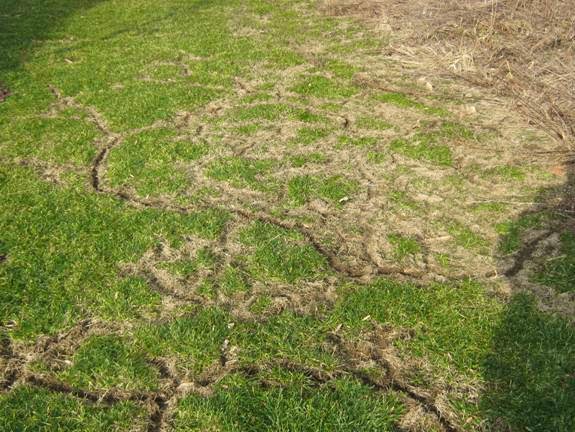Voles!
Last week’s article was on moles, and this week we cover voles. The names rhyme, but these animal pests of lawn and landscape are quite different.

Voles make mole-like “runs” in your yard, except that they appear to be well-traveled above-ground runs, rather than the more familiar burrowing damage created by moles. The nests of voles may be constructed on the surface, in underground burrows, or beneath the protection of some object lying on the ground.
Voles are a fairly common rodent in Indiana landscapes, except that they don’t get the same attention that the subterranean burrowing mole gets. And, the name “rodent” highlights the first difference between voles and moles. Voles are rodents who like to gnaw on things, while moles are insectivores that eat earthworms, millipedes, spiders, grubs, and other soil insects.
Dr. Timothy J. Gibb, Purdue integrated pest management specialist, has written about managing voles. Gibb said of the above ground runs, “These are vole highways.” He adds that although these runs are an eye-sore now, they do not significantly damage the turfgrass.

There are three species of voles in Indiana; the Meadow vole, Microtis pennsylvanicus, is the most common. Gibb said that people often refer to voles as meadow mice, or field mice. However, they are not the same animal as a mouse that you may find scurrying across the floor in your house.
Gibb said in general, voles are compact rodents with stocky bodies, short legs, and short tails. Their eyes are small and their ears partially hidden. They usually are brown or gray, though many color variations exist. The adult vole ranges from 3.5 to 5 inches in body length (5-7 inches including the tail), and weighs 1 to 2.5 ounces.
Voles are easily distinguished from moles in that moles have large feet, suitable for excavating those underground tunnels. Voles have feet that look more like a mouse.
Voles may also resemble shrews, which have a longer, pointier snout. Shrews and moles are more closely related as insectivores.
“Voles are herbivores,” said Gibb. “They eat seeds as well as leaves and stems of grasses and sometimes other green vegetation and occasionally, roots and bulbs.” Gibb said that voles are a pest of significance in turf and landscaped areas for two reasons; they tunnel and burrow in turf areas, and they gnaw on the trunks and roots of various trees and ornamental plants.
“Voles do not hibernate during the winter months,” said Gibb. “They are active even during the winter and when snow is on the ground.” He said they seem perfectly happy and actually do very well under the protection of the snow cover chewing away on the turfgrass plants. When the snow retreats what is left is a series of surface runways through turf areas.
“Voles can seriously injure trees, shrubs (and sometimes plastic irrigation lines) when they gnaw on them,” said Gibb. “And gnawing is what rodents do best!”
Gibb said that the most effective methods of managing voles in turf areas is via cultural practices, the use of traps (minor infestations), and the careful use of rodenticides.
“By eliminating weeds and dense ground cover around lawns, the capacity of these areas to support voles is reduced,” said Gibb. “Lawn and turf should be mowed regularly.” Excessive mulch around trees and shrubs should be avoided, as this is another favorite habitat and easy to tunnel through.
“Mouse snap traps can be used to control a small population by placing the trap perpendicular to the runway with the trigger end in the runway,” said Gibb. “A peanut butter-oatmeal mixture or apple slices make good baits.” Fall and late winter are periods when many vole species are easiest to trap, according to Gibb.
If you elect to use a rodenticide, extreme caution must be exercised. “These are mostly formulated as baits to be placed into burrow openings,” said Gibb. “Remember that other animals (including dogs and cats) dig for and prey on voles and will become exposed to baits if not used sparingly and properly.” Always consult state regulations, and use all pesticides strictly in accordance with label restrictions.
Search for Gibb’s recent advice on voles at Purdue Turf Tips, www.purdueturftips.blogspot.com/, and a Purdue Extension “Hot News” bulletin he authored, at: https://extension.entm.purdue.edu/publications/HN-67.pdf.
Images above from Purdue Extension publication HN-67-W, "Melting Snow Reveals Tiny Trails."
